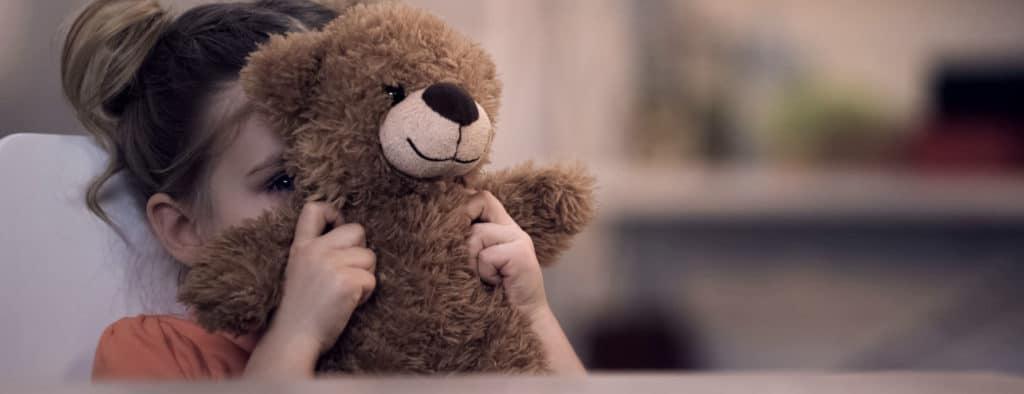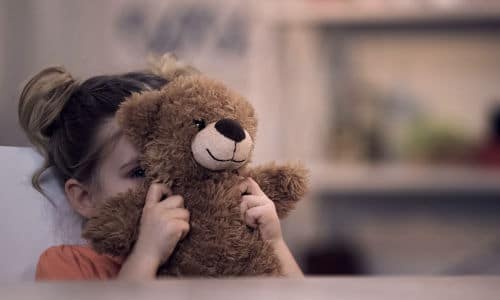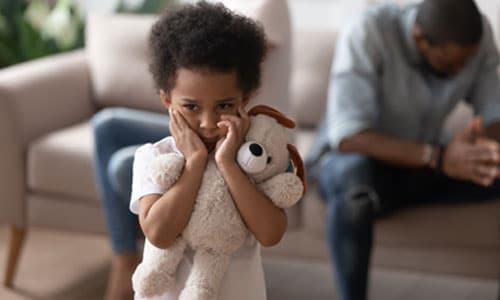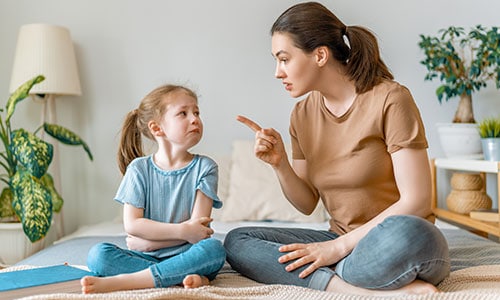
Anxiety can be very difficult for adults to cope with. For children, who generally lack the vocabulary and maturity to understand and clearly express what they are feeling, it can be even more difficult. However, a little knowledge, and some professional help, can make a huge difference.
The symptoms of childhood anxiety can include difficulty concentrating, problems with sleeping or recurring nightmares, difficulty eating and finishing meals, problems with anger management, excessive worry, excessive weeping or clinginess, and physical symptoms that might include needing to go to the bathroom often (in the absence of a problem such as a urinary tract infection) or stomach pains with no physical cause. It is not always clear what causes anxiety disorder in children. There may be a genetic component – a tendency towards anxiety can “run in” families – but often an incident or series of incidents can trigger anxiety, which can then escalate into a disorder, such as a bereavement, trauma, discord or violence in the family home, or sustained bullying at school. When childhood anxiety is left unaddressed, it can lead to a lifetime of problems, including chronic anxiety, panic attacks, difficulties with personal relationships and with retaining work, self-harming (including substance or alcohol abuse), and physical problems that are exacerbated by stress, including digestive issues, eczema and other skin disorders, and more.
Fortunately, childhood anxiety disorder, like an anxiety disorder in adults, can be effectively treated with one or a variety of treatment modalities that have been clinically proven to help. Even very anxious children, together with their parents or other caregivers, can learn to manage their condition well, so that its impacts on their lives are minimised.
Recognising Childhood Anxiety
For parents of anxious children, it can be difficult at first to recognise what their child is experiencing as anxiety. Children will often focus on and talk about the physical symptoms of the disorder. They might say that they don’t want to go to school or to a party because their tummy hurts, or complain of feeling nauseated and unwell. Of course, anyone can have a sore tummy or feel unwell, but when a child is experiencing these issues again and again, most often in association with particular situations, and when physical reasons for the problem have been ruled out, it may well be that they are suffering from anxiety.
Parents in this situation might consider keeping a log or diary to note when their child is having these symptoms. They might tend to occur in the mornings before school, on Sunday evenings as a new week begins, when their parents have to leave them to go to work or elsewhere, or on other occasions when the child has to leave the comfort and familiarity of home – or in other circumstances. Everyone is different, but when a child is suffering from childhood anxiety, it is likely that a pattern will emerge. Keeping a diary will help to recognise triggers, and will also help to develop coping mechanisms that can be activated to mitigate against the symptoms of anxiety disorder.
Talking About Childhood Anxiety
One of the most important things that parents can do to help their child with anxiety, and to help themselves in this situation, is to learn how to discuss the problem in a clear and matter-of-fact way. Of course, they can do this in the context of therapy for the child, which is often essential in helping them to learn how to manage the condition – but they can also practice at home and develop a vocabulary and way of discussing the issue that the child finds accessible.
Parents sometimes feel that by ignoring a psychological problem such as anxiety, they can show their child that it is not really that big a deal and that this will help them to recover, or that by talking about it they are “giving it attention” and encouraging the child to default to “anxious mode” at the drop of a hat, or to engage in attention-seeking behaviour. They can think that, by talking about their child’s anxiety, they are giving them a ready-made excuse for all sorts of bad behaviour. In fact, helping an anxious child to learn how to discuss their anxiety is empowering in and of itself, and is an essential tool in managing the condition and minimising symptoms, including obstructive and unhelpful behaviours. A child whose anxiety disorder is not seen as a taboo topic is much more likely to be able to manage their conduct in an appropriate manner.
With patience and care, the caregivers of an anxious child can model how to talk about anxiety using phrases like the following:
- I am sorry that you have a pain in your tummy. Do you think it might be because you are a little anxious about the new teacher coming in? It’s OK to be nervous and we can talk about it if you want.
- You seem upset today. We’re all going to a party at Anthony’s later and, while that’s exciting, I wonder if maybe you’re also a little anxious about being in such a big crowd and not knowing anyone.
- I know that you are worried about something going wrong at the school concert. That’s OK! We can talk about it if you like.
It may take some time and practice, and possibly input from a suitably qualified child therapist, but gradually your child can learn how to talk about what they are experiencing. As they do, the problem will become smaller, less daunting, and less of a trigger for anxiety symptoms. It will also become easier for your child to discuss their anxiety with other caregivers and with teachers, which is enormously important. A child who is experiencing severe anxiety at school, with no way to explain what they are going through, is liable to reach a point whereby they have a “meltdown”, for which they may be punished, leading to a deeply unhelpful cycle of anxiety-misbehaviour-punishment-anxiety. By empowering them, with an accessible vocabulary and an understanding of what they are experiencing, much of this can be averted.
Dealing with Challenges
Parents of anxious children often, quite understandably, want to wrap them in cotton wool and protect them from stress as much as possible. However, this is not a realistic or a useful approach to take. Children with anxiety have to learn coping mechanisms and resilience in the face of challenges – just like all other children, but even more so.
One of the big issues for a lot of children with anxiety is that they often internalise criticism or other negative interactions with others and assume that it is all their fault or that they have done something wrong. Inevitably, in school, in the playground, or with their siblings or friends, there will be times when someone criticises them, contradicts them, or even bullies them. When this happens, it can trigger a panic attack and sometimes also unconstructive behaviour that can seem disproportionate to the original event. Or, conversely, a child with anxiety can even become a bully, seeking to push people away because they are afraid of getting too close, or feel that they need to retain a sense of being in control of their social situation. Sometimes the child reacts by becoming so still and silent that they, and their distress, can easily be overlooked.
In these circumstances, anxious children need to learn de-escalation skills. They can be taught how to remind themselves that they deserve to be respected, and that when someone is “mean” or unfair, it does not follow that it is all their fault. If they are experiencing bullying, or are struggling to deal with their own behaviour around other children, they need to know that they can go to the responsible adult in the situation and explain what is going on. If they have already been helped to acquire the vocabulary they need to discuss their anxiety, all of this will be much easier.
Other challenges that can be much more difficult for children with anxiety than for others include losses and bereavement. Everyone is sad when a beloved family member, friend, or pet dies, for example, but whereas children without anxiety grieve, mourn, and acquire resilience through coping with normal adverse situations, for children with anxiety, coping with these inevitable challenges in life can be much more difficult. Allowing them to talk about what they are feeling, and helping them to find the words they need to describe their emotions, is absolutely essential.
Social media can be a significant challenge for all children, not just those with anxiety. Very young children should simply not be allowed to use social media and the internet unsupervised. Older children, inevitably, are likely to use one or more social media platforms and to browse a range of content providers. It can be very challenging – for everyone, not just kids – to remember that the images people present of themselves on social media are not necessarily real. Children with anxiety disorder often experience an exacerbation in their symptoms when they use social media to excess or without supervision. Help them by limiting their time online and ensuring that they understand that what they are seeing does not necessarily represent reality.
Communication and Routine
One of the things that children with anxiety find most difficult to manage is the unexpected. A surprise classroom test, an unexpected visitor, or even something as simple as breakfast or dinner not being served at the usual time, can all be triggers for anxiety. Parents and caregivers can help by establishing a predictable routine in the home, and doing simple things such as ensuring that the same breakfast cereal is always available. It is also important for caregivers and teachers to communicate as clearly as possible when there are going to be variations in the usual routine: “Now, I know Granny said that she was going to come over later today, but she has to get the car fixed, so she is coming over tomorrow instead. So she won’t be here when you get home from school like you expected, but she is really looking forward to seeing you tomorrow,” or, “Now, I am going to give you all a test today, which I know you weren’t expecting. We won’t do it straight away, let’s do it in an hour, so that we all have time to get used to the idea.”
Anxious children can also learn self-soothing techniques that will help them to cope when there are changes to their routine, and in other circumstances that they find challenging.
Self-soothing
Children with anxiety can find it very useful to know some self-soothing techniques that they can employ as soon as they realise that they are becoming anxious. These can include giving themselves a “time out” (which can mean having to communicate with a teacher or other responsible adult that they need one), using deep breathing techniques to reduce their heart rate and mitigate against symptoms of panic, and using simple positive psychology to calm themselves when they start to become aware of a burgeoning sense of anxiety. A therapist qualified to work with children can help them and their families to devise an approach that supports their needs.
Therapy for Childhood Anxiety
There are lots of ways in which parents and caregivers can help their anxious children to understand their condition, self-soothe or self-calm, and learn how to manage it. However, for most people, the journey towards a better place, in which anxiety is no longer the ruling emotion, starts with seeing a therapist. A suitably qualified, empathetic child therapist can make a huge difference – firstly by recognising and diagnosing the condition, and then by working with the child and their caregivers to come up with a plan in terms of how to manage and ameliorate the condition in the longer term. Often just a few sessions, with the option of returning every so often for a “refresher” session, or to deal with a specific situation, can make an enormous difference.
Children with anxiety disorder do not have to just live with feeling anxious all the time and with all the negative side effects of the condition. Yes, it is possible that they will grow up to be adults who still have a tendency towards anxiety – but with knowledge, a useful vocabulary to discuss the issue, and the awareness that support is available, from childhood on they can absolutely keep the impact on their lives to a minimum.















